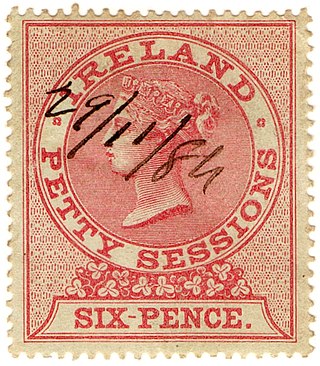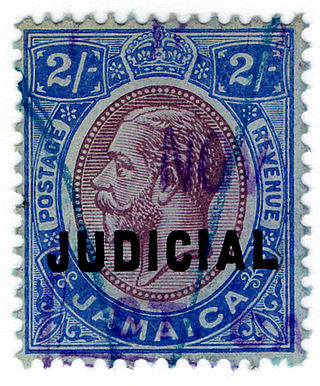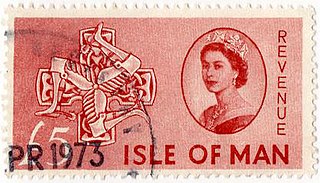
Key type stamps are stamps of a uniform design that were widely used by colonial territories in the 19th and 20th centuries.

India has been a heavy user of revenue stamps, both before and after independence. The first revenues were issued in the mid-nineteenth century and they are still being issued to this day. Apart from issues for the whole of India, many princely states, provinces and other states also had or still have their own revenue stamp issues.
The Board of Inland Revenue Stamping Department Archive in the British Library contains artefacts from 1710 onwards, and has come into existence through amendments in United Kingdom legislation.

Revenue stamps of Malta were first issued in 1899, when the islands were a British colony. From that year to 1912, all revenue issues were postage stamps overprinted accordingly, that was either done locally or by De La Rue in London. Postage stamps also became valid for fiscal use in 1913, so no new revenues were issued until 1926–1930, when a series of key type stamps depicting King George V were issued. These exist unappropriated for use as general-duty revenues, or with additional inscriptions indicating a specific use; Applications, Contracts, Registers or Stocks & Shares. The only other revenues after this series were £1 stamps depicting George VI and Elizabeth II. Postage stamps remained valid for fiscal use until at least the 1980s.

Revenue stamps of the United Kingdom refer to the various revenue or fiscal stamps, whether adhesive, directly embossed or otherwise, which were issued by and used in the Kingdom of England, the Kingdom of Great Britain, the United Kingdom of Great Britain and Ireland and the United Kingdom of Great Britain and Northern Ireland, from the late 17th century to the present day.

Revenue stamps of Ireland refer to the various revenue or fiscal stamps, whether adhesive, directly embossed or otherwise, which have been used on the island of Ireland since 1774. These include issues by the Kingdom of Ireland, issues by the United Kingdom specifically for use in Ireland or briefly Southern Ireland, and issues of an independent southern Ireland since 1922. Revenue stamps of Northern Ireland were also issued from 1921 to the 1980s, but they are not covered in this article.

Pakistan first issued revenue stamps when it became independent in 1947 and continues to issue revenues to this day. In addition to national issues, the provinces of Balochistan, North West Frontier, Punjab, Sindh, as well as Azad Jammu and Kashmir, West Pakistan and the capital Islamabad also have or had their own stamps.

The island of Cyprus first issued revenue stamps in 1878 and continues to do so to this day. The Turkish Republic of Northern Cyprus also issues its own revenue stamps.

Revenue stamps of British Guiana refer to the various revenue or fiscal stamps, whether adhesive or directly embossed, which were issued by British Guiana prior to the colony's independence as Guyana in 1966. Between the 1860s and 1890s, the colony issued Inland Revenue and Summary Jurisdiction stamps, while revenue stamps and dual-purpose postage and revenue stamps were issued during the late 19th and 20th centuries. In around the 1890s or 1900s, British Guiana possibly issued stamps for taxes on medicine and matches, but it is unclear if these were actually issued. Guyana continued to issue its own revenue stamps after independence.
Bangladesh first issued revenue stamps in 1972, the year after independence, and continues to do so to this day. Previously there was no country named Bangladesh and it was part of India and part of Pakistan and respective revenues were used. From 1921 to 1947 various Indian revenues were overprinted BENGAL for use in modern Bangladesh and West Bengal.

Kenya, formerly known as British East Africa issued revenue stamps since 1891. There were numerous types of revenue stamps for a variety of taxes and fees. Also valid for fiscal use in Kenya were postage stamps issued by the following entities:

Revenue stamps of Jamaica were first issued in 1855. There were various types of fiscal stamps for different taxes.

Revenue stamps of the Isle of Man refer to the adhesive revenue or fiscal stamps which were issued by the British Crown dependency of the Isle of Man between 1889 and 1976. British key type revenue stamps with an appropriate inscription were issued on the island until 1966, when revenue stamps showing various scenes and symbols of the island began to be issued. The last set of stamps was issued in 1976. From around 1920 to the 1970s, hundreds of contribution stamps were issued for National Insurance and related schemes.

Uganda issued revenue stamps from around 1896 to the 1990s. There were numerous types of revenue stamps for a variety of taxes and fees.
Revenue stamps of Seychelles were first issued in 1893, when the islands were a dependency of the British Crown Colony of Mauritius. The first stamps were Mauritius Internal Revenue stamps depicting Queen Victoria overprinted for use in Seychelles, and Bill stamps were also similarly overprinted. Postage stamps depicting Victoria or Edward VII were overprinted for fiscal use at various points between 1894 and 1904, while surcharges on Bill stamps were made in around 1897–98.

Revenue stamps of Hawaii were first issued in late 1876 by the Kingdom of Hawaii to pay taxes according to the Stamp Duty Act of 1876, although embossed revenue stamps had been introduced decades earlier in around 1845. The stamps issued in 1876–79 were used for over three decades, remaining in use during the Provisional Government, the Republic and after Hawaii became a U.S. Territory. Some changes were made along the years: from rouletted to perforated, and some new values, colours, designs and overprints were added. Some postage stamps were briefly valid for fiscal use in 1886–88 to pay for a tax on opium imports, and a stamp in a new design was issued for customs duties in 1897. A liquor stamp was issued in 1905.
Few revenue stamps of Nigeria and its predecessor states have been issued, since most of the time dual-purpose postage and revenue stamps were used for fiscal purposes. The first revenue-only stamps were consular stamps of the Niger Coast Protectorate and the Southern Nigeria Protectorate, which were created by overprinting postage stamps in 1898 and 1902 respectively. The Northern Nigeria Protectorate did not issue any specific revenue stamps, but a £25 stamp of 1904 could not be used for postal purposes due to its extremely high face value.
Revenue stamps of Scotland refer to the adhesive revenue or fiscal stamps which were used in Scotland, a constituent country of the United Kingdom, between 1871 and the 1970s. Regular revenue stamps of the United Kingdom were widely used throughout the country, but revenue stamps for exclusive use in Scotland were issued for Law Courts and Register House.
British Somaliland, a British protectorate in present-day Somaliland, issued adhesive revenue or fiscal stamps between 1900 and 1904. All Somaliland fiscals were revenue stamps of India overprinted BRITISH SOMALILAND.
Revenue stamps of Guyana refer to the various revenue or fiscal stamps, whether adhesive, directly embossed or otherwise, which have been issued by Guyana since its independence in 1966. Prior to independence, the country was known as British Guiana, and it had issued its own revenue stamps since the 19th century. Guyana used dual-purpose postage and revenue stamps until 1977, and it issued revenue-only stamps between 1975 and the 2000s. The country has also issued National Insurance stamps, labels for airport departure tax and excise stamps for cigarettes and alcohol.














